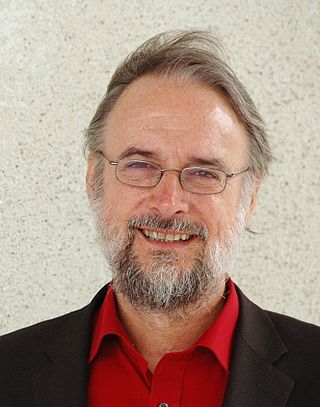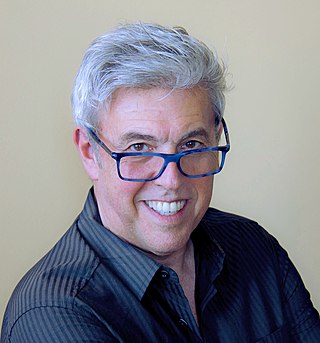Related Research Articles
European Strategic Programme on Research in Information Technology (ESPRIT) was a series of integrated programmes of information technology research and development projects and industrial technology transfer measures. It was a European Union initiative managed by the Directorate General for Industry of the European Commission.
Speech recognition is an interdisciplinary subfield of computer science and computational linguistics that develops methodologies and technologies that enable the recognition and translation of spoken language into text by computers with the main benefit of searchability. It is also known as automatic speech recognition (ASR), computer speech recognition or speech to text (STT). It incorporates knowledge and research in the computer science, linguistics and computer engineering fields. The reverse process is speech synthesis.
Speech synthesis is the artificial production of human speech. A computer system used for this purpose is called a speech synthesizer, and can be implemented in software or hardware products. A text-to-speech (TTS) system converts normal language text into speech; other systems render symbolic linguistic representations like phonetic transcriptions into speech. The reverse process is speech recognition.

Karlheinz Brandenburg is a German electrical engineer and mathematician. Together with Ernst Eberlein, Heinz Gerhäuser, Bernhard Grill, Jürgen Herre and Harald Popp, he developed the widespread MP3 method for audio data compression. He is also known for his elementary work in the field of audio coding, the perception measurement, the wave field synthesis and psychoacoustics. Brandenburg has received numerous national and international research awards, prizes and honors for his work. Since 2000 he has been a professor of electronic media technology at the Technical University Ilmenau. Brandenburg was significantly involved in the founding of the Fraunhofer Institute for Digital Media Technology (IDMT) and currently serves as its director.
Speaker recognition is the identification of a person from characteristics of voices. It is used to answer the question "Who is speaking?" The term voice recognition can refer to speaker recognition or speech recognition. Speaker verification contrasts with identification, and speaker recognition differs from speaker diarisation.
Multimodal interaction provides the user with multiple modes of interacting with a system. A multimodal interface provides several distinct tools for input and output of data.

A dialogue system, or conversational agent (CA), is a computer system intended to converse with a human. Dialogue systems employed one or more of text, speech, graphics, haptics, gestures, and other modes for communication on both the input and output channel.
Gennady Simeonovich Osipov was a Russian scientist, holding a Ph.D. and a Dr. Sci. in theoretical computer science, information technologies and artificial intelligence. He was the vice-president of the Institute for Systems Analysis of the Russian Academy of Sciences, professor at the Moscow Institute of Physics and Technology, and at Bauman Moscow State Technical University. Osipov has contributed to the Theory of Dynamic Intelligent Systems and heterogeneous semantic networks used in applied intelligent systems.
Richard J. Mammone is an American engineer, inventor, entrepreneur and professor. As an inventor, he holds over 15 patents. To date, he has formed four technology companies including SpeakEZ, a firm that specialized in voice recognition technology, and Computed Anatomy Inc., the business that pioneered LASIK eye surgery.

Roberto Pieraccini is an Italian and US electrical engineer working in the field of speech recognition, natural language understanding, and spoken dialog systems. He is currently Director of Engineering at Google in Zurich, Switzerland, within the Google Assistant organization. He has been an active contributor to speech research and technology since 1981.
Loquendo is a multinational computer software technology corporation, headquartered in Torino, Italy, that provides speech recognition, speech synthesis, speaker verification and identification applications. Loquendo, which was founded in 2001 under the Telecom Italia Lab, also had offices in United Kingdom, Spain, Germany, France, and the United States.
The following outline is provided as an overview of and topical guide to natural-language processing:
Julia Hirschberg is an American computer scientist noted for her research on computational linguistics and natural language processing.
Centro Studi e Laboratori Telecomunicazioni (CSELT) was an Italian research center for telecommunication based in Torino, the biggest in Italy and one of the most important in Europe. It played a major role internationally especially in the standardization of protocols and technologies in telecommunication: perhaps the most widely well known is the standardization of mp3. CSELT has been active from 1964 to 2001, initially as a part of the Istituto per la Ricostruzione Industriale-STET – Società Finanziaria Telefonica group, the major conglomerate of Italian public Industries in the 1960s and 1970s; it later became part of Telecom Italia Group. In 2001 was renamed TILAB as part of Telecom Italia Group.
Eloquens™ is a Text-To-Speech software, whose first version was released in 1993 by CSELT. It was the first commercial speech synthesis software able to speak Italian.

Stephen John Young is a British researcher, Professor of Information Engineering at the University of Cambridge and an entrepreneur. He is one of the pioneers of automated speech recognition and statistical spoken dialogue systems. He served as the Senior Pro-Vice-Chancellor of the University of Cambridge from 2009 to 2015, responsible for planning and resources. From 2015 to 2019, he held a joint appointment between his professorship at Cambridge and Apple, where he was a senior member of the Siri development team.

MUSA was an early prototype of Speech Synthesis machine started in 1975.
RIPAC was a VLSI single-chip microprocessor designed for automatic recognition of the connected speech, one of the first of this use.
Jiebo Luo is a Chinese-American computer scientist, Professor of Computer Science at the University of Rochester and Distinguished Researcher with Goergen Institute for Data Science. He is interested in artificial intelligence, data science and computer vision.
References
- ↑ "'A little semantics goes a long way', milanin.com, 2008". Archived from the original on 2016-04-30. Retrieved 2016-11-21.
- ↑ Luigi Bonavoglia, CSELT: Trent'anni, 1994 Ed. STET
- ↑ Alberto Ciaramella racconta il brevetto del boostrap dei computer concepito in CSELT, interview by Vittorio Pasteris of the Piemonte Museum of Computer Science
- ↑ Billi, Roberto, et al. "Interactive voice technology at work: The CSELT experience." Interactive Voice Technology for Telecommunications Applications, 1994, Second IEEE Workshop on. IEEE, 1994.
- ↑ Danieli, Morena, and Elisabetta Gerbino. "Metrics for evaluating dialogue strategies in a spoken language system." Proceedings of the 1995 AAAI spring symposium on Empirical Methods in Discourse Interpretation and Generation. Vol. 16. 1995.
- ↑ Ciaramella, Alberto. "A prototype performance evaluation report." Sundial workpackage 8000 (1993).
- ↑ Cavazza, Michele, and Alberto Ciaramella. "Device for speaker's verification." U.S. Patent No. 4,752,958. 21 Jun. 1988.
- ↑ DeMori, Renato, and Ching Y. Suen, eds. New systems and architectures for automatic speech recognition and synthesis. Vol. 16. Springer Science & Business Media, 2012.
- ↑ Capizzi, Giuseppe N. "Digital speech synthesizer." The Journal of the Acoustical Society of America 87.4 (1990): 1831-1831.
- ↑ Cecinati, R., Ciaramella, A., Licciardi, L., Paolini, M., Tasso, R., & Venuti, G. (1990). U.S. Patent No. 4,907,278. Washington, DC: U.S. Patent and Trademark Office.
- ↑ Cecinati, R., Ciaramella, A., Licciardi, L., & Venuti, G. (1989). Implementation of a dynamic time warp integrated circuit for large vocabulary isolated and connected speech recognition. In First European Conference on Speech Communication and Technology.
- ↑ Cantoni, Virginio, Gabriele Falciasecca, and Giuseppe Pelosi, eds. Storia delle telecomunicazioni. Vol. 1. Firenze University Press, 2011.APA, (pag.394)
- ↑ ""CSELT, da 50 anni verso il futuro", Telecom Italia" (PDF). Archived from the original (PDF) on 2016-11-28. Retrieved 2016-11-27.
- ↑ Baggia, P., Ciaramella, A., Clementino, D., Fissore, L., Gerbino, E., Giachin, E. P., ... & Rullent, C. (1991). A man-machine dialogue system for speech access to E-mail information using the telephone: implementation and first results. In Second European Conference on Speech Communication and Technology.
- ↑ "Tecnologia matura e finalmente aperta - Intervista ad Alberto Ciaramella", Computer World, November 2001
- ↑ IntelliSemantic
- ↑ Bonino, Dario, Alberto Ciaramella, and Fulvio Corno. "Review of the state-of-the-art in patent information and forthcoming evolutions in intelligent patent informatics." World Patent Information 32.1 (2010): 30-38.
- ↑ Brügmann, S., Bouayad-Agha, N., Burga, A., Carrascosa, S., Ciaramella, A., Ciaramella, M., ... & Müller, A. (2015). Towards content-oriented patent document processing: Intelligent patent analysis and summarization. World Patent Information, 40, 30-42.